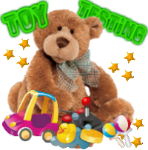Is it possible to manufacture a toy and put it on the market without any thought of safety? Absolutely not and to ensure children's safety is a priority there are such things as toy safety regulations. Around the world, in various countries, toys being sold commercially have to pass safety standards. The standards are in place to prevent accidents. In Canada, there are a number of different regulations covering toys in place.
Toys regulations in Canada cover a number of different types of hazard relating to children's toys and a variety of different requirements are laid down that are designed to protect children. These include mechanical hazards that include strangulation, suffocation, choking, lacerations and punctures. Risks from burns and fire, electrocution and shock. Toys regulations also set out the way toys should be tested and the criteria that need to be met.
Canadian Safety Requirements for Children's Toys – Toys Regulations (SOR/2011-17)
When it comes to toy safety there are requirements set out in the Canada Consumer Product Safety Act. There are also a number of different regulations that specifically address hazards in relations to children's toys. The main regulation if the Toys Regulation, and this is a new act that was put in place in 2011 to replace the Hazardous Products (Toys) Regulations. The regulations contain a number of different safety requirements relating to mechanical flammability, electrical, thermal, toxicological and any other hazards relating to toys for children. As well as the Toys Regulations there are also other regulations that apply to the design and construction of the toy as well as how it will be marketed and what it's made of. These are:
- Asbestos Products Regulations
- Consumer Products Containing Lead (Contact with Mouth ) Regulations
- Glazed Ceramics and Glassware Regulations
- Phthalates Regulations
- Science Education Sets Regulations
- Surface Coating Materials Regulations
- Textile Flammability Regulations
While the regulations in place are able to protect children to a certain extent, it is still down to parents to ensure the toys they give their children will not cause them injury.
What can parents do to keep their children safe?
Toys in Canada are regulated to ensure that they pose no risk for the children that are using them. Nevertheless, there have still been instances of unsafe toys getting into the stores and then into peoples homes. It's not just the toys that can pose a risk either. It can also be the way in which they are used. At the end of the day, ultimate responsibility is in the hands of parents anyway. Being aware of the risks is the best way to protect a child's health and keep them safe.
General tips for keeping children safe
- Only buy toys that are sturdy and well-made, with manufacturers contact information included
- Look for age labels and safety messages and make sure you read and follow them. If the toy is designed for older children it may have small parts or other hazards that would make them unsuitable for younger children.
- Toys that are small or have small parts or loose accessories should be kept away from young children, particularly those under three years of age. This is because children of this age are more likely to put items in their mouth and there is an increased risk of choking.
- Toys that are broken should be repaired or thrown away. Regularly check you children's toys for broken or missing pieces, sharp edges and any parts that are loose.
- All toys should be kept away from sources of heat. Particularly soft and plush toys
- If using a toy box it should be one without a lid. Lids can fall and injure a child or trap them inside. If the toy box does have a lid make sure it is not heavy and has holes to allow for air flow.
- Riding toys should be right for a child's age, ability and size
- Ride-on toys should be stable
- Don't let a child use a ride-on toy near stairs, swimming pools or in other dangerous areas.
- Trampolines should only be used by children over six and adult supervision is imperative
